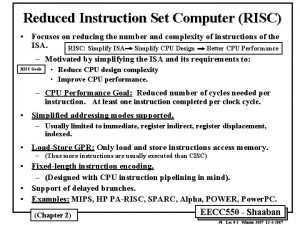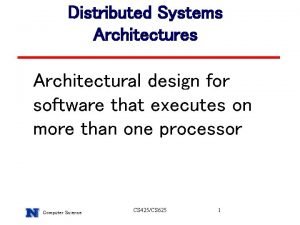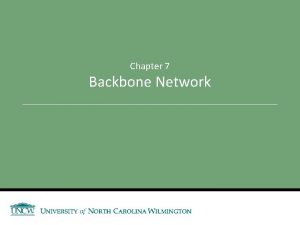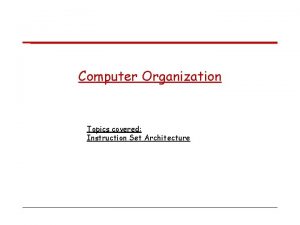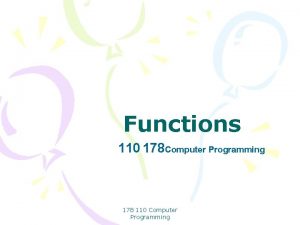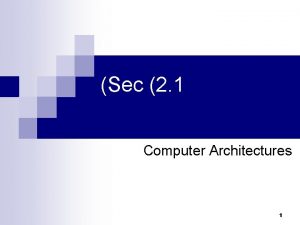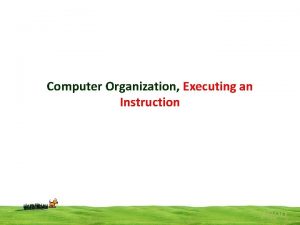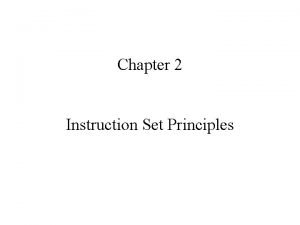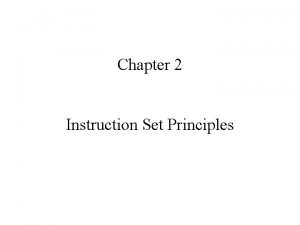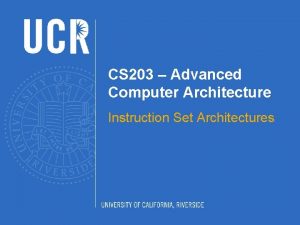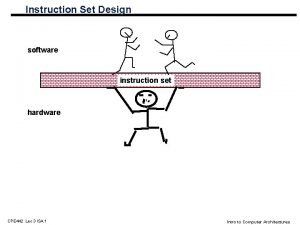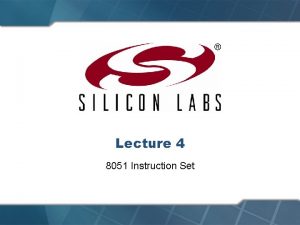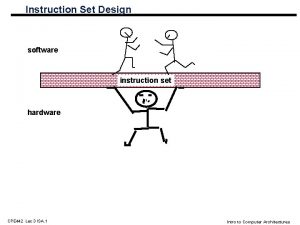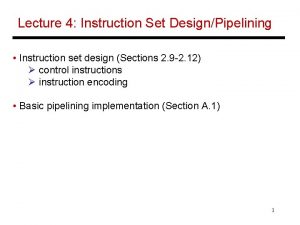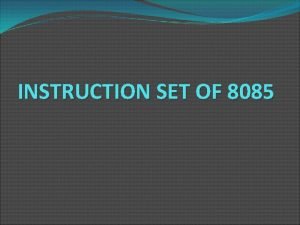Instruction Set Architectures IT 110 Computer Organization Instruction
































- Slides: 32

Instruction Set Architectures IT 110: Computer Organization

Instruction Set Architectures ISA determines instruction formats – The LMC is a one-address architecture (an accumulator-based machine). IT 110: Computer Organization

Instruction Set Architectures ISA determines instruction formats – The LMC is a one-address architecture (an accumulator-based machine). – e. g. , the instruction ADD X ADD takes two operands. One is implicit (the accumulator). The other is an address (location). IT 110: Computer Organization

Instruction Set Architectures ISA determines instruction formats – There are other instruction set architectures, all based on the number of explicit operands. – – 0 -address (stack) 1 -address (accumulator) 2 -address 3 -address IT 110: Computer Organization

Instruction Set Architectures 0 -Address Machines – All operands for binary operations are implicit on the stack. Only push/pop reference memory. – e. g. , calculating a=a*b+c–d*e IT 110: Computer Organization

Instruction Set Architectures 0 -Address Machines – All operands for binary operations are implicit on the stack. Only push/pop Code reference memory. PUSH A – e. g. , calculating a=a*b+c–d*e # Memory Refs Stack 1 PUSH B 1 MUL 0 PUSH C 1 PUSH D 1 PUSH E 1 MUL 0 SUB 0 ADD 0 POP A 1 IT 110: Computer Organization

Instruction Set Architectures 0 -Address Machines – All operands for binary operations are implicit on the stack. Only push/pop Code reference memory. PUSH A – e. g. , calculating a=a*b+c–d*e # Memory Refs Stack 1 PUSH B 1 MUL 0 PUSH C 1 PUSH D 1 PUSH E 1 MUL 0 SUB 0 ADD 0 POP A 1 IT 110: Computer Organization a

Instruction Set Architectures 0 -Address Machines – All operands for binary operations are implicit on the stack. Only push/pop Code reference memory. – e. g. , calculating a=a*b+c–d*e # Memory Refs Stack PUSH A 1 PUSH B 1 MUL 0 PUSH C 1 PUSH D 1 PUSH E 1 MUL 0 SUB 0 ADD 0 b POP A 1 a IT 110: Computer Organization

Instruction Set Architectures 0 -Address Machines – All operands for binary operations are implicit on the stack. Only push/pop Code reference memory. – e. g. , calculating a=a*b+c–d*e # Memory Refs PUSH A 1 PUSH B 1 MUL 0 PUSH C 1 PUSH D 1 PUSH E 1 MUL 0 SUB 0 ADD 0 POP A 1 Stack IT 110: Computer Organization a * b

Instruction Set Architectures 0 -Address Machines – All operands for binary operations are implicit on the stack. Only push/pop Code reference memory. – e. g. , calculating a=a*b+c–d*e # Memory Refs Stack PUSH A 1 PUSH B 1 MUL 0 PUSH C 1 PUSH D 1 PUSH E 1 MUL 0 SUB 0 ADD 0 c POP A 1 a * b IT 110: Computer Organization

Instruction Set Architectures 0 -Address Machines – All operands for binary operations are implicit on the stack. Only push/pop Code reference memory. – e. g. , calculating a=a*b+c–d*e # Memory Refs Stack PUSH A 1 PUSH B 1 MUL 0 PUSH C 1 PUSH D 1 PUSH E 1 MUL 0 SUB 0 d ADD 0 c POP A 1 a * b IT 110: Computer Organization

Instruction Set Architectures 0 -Address Machines – All operands for binary operations are implicit on the stack. Only push/pop Code reference memory. – e. g. , calculating a=a*b+c–d*e # Memory Refs Stack PUSH A 1 PUSH B 1 MUL 0 PUSH C 1 PUSH D 1 PUSH E 1 MUL 0 e SUB 0 d ADD 0 c POP A 1 a * b IT 110: Computer Organization

Instruction Set Architectures 0 -Address Machines – All operands for binary operations are implicit on the stack. Only push/pop Code reference memory. – e. g. , calculating a=a*b+c–d*e # Memory Refs Stack PUSH A 1 PUSH B 1 MUL 0 PUSH C 1 PUSH D 1 PUSH E 1 MUL 0 SUB 0 d * e ADD 0 c POP A 1 a * b IT 110: Computer Organization

Instruction Set Architectures 0 -Address Machines – All operands for binary operations are implicit on the stack. Only push/pop Code reference memory. PUSH A – e. g. , calculating a=a*b+c–d*e # Memory Refs Stack 1 PUSH B 1 MUL 0 PUSH C 1 PUSH D 1 PUSH E 1 MUL 0 SUB 0 ADD 0 c – (d * e) POP A 1 a * b IT 110: Computer Organization

Instruction Set Architectures 0 -Address Machines – All operands for binary operations are implicit on the stack. Only push/pop Code reference memory. – e. g. , calculating a=a*b+c–d*e # Memory Refs PUSH A 1 PUSH B 1 MUL 0 PUSH C 1 PUSH D 1 PUSH E 1 MUL 0 SUB 0 ADD 0 POP A 1 Stack a * b + (c – (d * e)) IT 110: Computer Organization

Instruction Set Architectures 0 -Address Machines – All operands for binary operations are implicit on the stack. Only push/pop Code reference memory. – e. g. , calculating a=a*b+c–d*e # Memory Refs PUSH A 1 PUSH B 1 MUL 0 PUSH C 1 PUSH D 1 PUSH E 1 MUL 0 SUB 0 ADD 0 POP A 1 Stack IT 110: Computer Organization

Instruction Set Architectures 0 -Address Machines – All operands for binary operations are implicit on the stack. Only push/pop Code reference memory. – e. g. , calculating a=a*b+c–d*e # Memory Refs PUSH A 1 PUSH B 1 MUL 0 PUSH C 1 PUSH D 1 PUSH E 1 MUL 0 SUB 0 ADD 0 POP A 1 Stack In a stack-based machine, the stack is typically a set of very fast registers, minimizing trips to memory; 6 memory accesses, not including instruction fetch. IT 110: Computer Organization

Instruction Set Architectures 1 -Address Machines – Accumulator is a source and destination. Second source is explicit. IT 110: Computer Organization

Instruction Set Architectures 1 -Address Machines – Accumulator is a source and destination. Second source is explicit. – e. g. , calculating a=a*b+c–d*e Code # Memory Refs LOAD A 1 MUL B 1 ADD C 1 STORE T 1 1 LOAD D 1 MUL E 1 STORE T 2 1 LOAD T 1 1 SUB T 2 1 STORE A 1 IT 110: Computer Organization

Instruction Set Architectures 1 -Address Machines – Accumulator is a source and destination. Second source is explicit. – e. g. , calculating a=a*b+c–d*e Code # Memory Refs LOAD A 1 MUL B 1 ADD C 1 STORE T 1 1 LOAD D 1 MUL E 1 STORE T 2 1 LOAD T 1 1 SUB T 2 1 STORE A 1 10 memory references, not including instruction fetch. IT 110: Computer Organization

Instruction Set Architectures 2 -Address Machines – Two source addresses for operands. One source is also the destination. Addr 1 is both source and destination. IT 110: Computer Organization

Instruction Set Architectures 2 -Address Machines – Two source addresses for operands. One source is also the destination. – e. g. , calculating a=a*b+c–d*e Code # Memory Refs MOVE T 1, A 2 MUL T 1, B 3 ADD T 1, C 3 MOVE T 2, D 2 MUL T 2, E 3 SUB T 1, T 2 3 MOVE A, T 1 2 IT 110: Computer Organization

Instruction Set Architectures 2 -Address Machines – Two source addresses for operands. One source is also the destination. – e. g. , calculating a=a*b+c–d*e Code # Memory Refs MOVE T 1, A 2 MUL T 1, B 3 ADD T 1, C 3 MOVE T 2, D 2 MUL T 2, E 3 SUB T 1, T 2 3 MOVE A, T 1 2 Using memory-tomemory operations, 18 memory accesses (not including instruction fetch). What if T 1 and T 2 were registers? IT 110: Computer Organization

Instruction Set Architectures 2 -Address Machines – Two source addresses for operands. One source is also the destination. – e. g. , calculating a=a*b+c–d*e Code # Memory Refs MOVE R 1, A 1 MUL R 1, B 1 ADD R 1, C 1 MOVE R 2, D 1 MUL R 2, E 1 SUB R 1, T 2 0 MOVE A, R 1 1 Cuts memory references down to 6. This is called a 1½ address machine with a load/store architecture. IT 110: Computer Organization

Instruction Set Architectures 3 -Address Machines – One destination operand, two source operands, all explicit IT 110: Computer Organization

Instruction Set Architectures 3 -Address Machines – One destination operand, two source operands, all explicit – e. g. , calculating a=a*b+c–d*e Code # Memory Refs MPY T 1, A, B 3 ADD T 1, C 3 MPY T 2, D, E 3 SUB A, T 1, T 2 3 IT 110: Computer Organization

Instruction Set Architectures 3 -Address Machines – One destination operand, two source operands, all explicit – e. g. , calculating a=a*b+c–d*e Code # Memory Refs MPY T 1, A, B 3 ADD T 1, C 3 MPY T 2, D, E 3 SUB A, T 1, T 2 3 12 memory accesses, not including instruction fetch. What if T 1, T 2 were registers? IT 110: Computer Organization

Instruction Set Architectures 3 -Address Machines – One destination operand, two source operands, all explicit – e. g. , calculating a=a*b+c–d*e Code # Memory Refs MPY R 1, A, B 2 ADD R 1, C 1 MPY R 2, D, E 2 SUB A, R 1, R 2 1 6 memory accesses; general purpose registers make a substantial difference. IT 110: Computer Organization

Instruction Set Architectures Comparison – Assume 8 registers (3 bits), 32 op-codes (5 bits), 15 -bit addresses, 16 -bit integers. – Which ISA accesses memory the least? IT 110: Computer Organization

Instruction Set Architectures Comparison – Assume 8 registers (3 bits), 32 op-codes (5 bits), 15 -bit addresses, 0 -address 16 -bit integers. – Which ISA accesses 1 -address memory the least? Instructions Data refs Total 10 x 20 bits = 200 bits 6 x 16 bits = 96 bits 296 bits 10 x 20 bits = 200 bits 10 x 16 bits = 160 bits 360 bits 1½-address 7 x 23 bits = 161 bits 6 x 16 bits = 96 bits 257 bits 2 address 7 x 35 bits = 245 bits 18 x 16 bits = 288 bits 519 bits 3 -address 4 x 50 bits = 200 bits 12 x 16 bits =192 bits 3 -address (regs) 4 x 38 bits = 152 bits 6 x 16 bits = 96 bits 248 bits IT 110: Computer Organization

Instruction Set Architectures Comparison – Assume 8 registers (3 bits), 32 op-codes (5 bits), 15 -bit addresses, 0 -address 16 -bit integers. – Which ISA accesses 1 -address memory the least? Two clear winners: 1½‐address (RISC) and 3‐address with registers (CISC). Data refs Instructions Total 10 x 20 bits = 200 bits 6 x 16 bits = 96 bits 296 bits 10 x 20 bits = 200 bits 10 x 16 bits = 160 bits 360 bits 1½-address 7 x 23 bits = 161 bits 6 x 16 bits = 96 bits 257 bits 2 address 7 x 35 bits = 245 bits 18 x 16 bits = 288 bits 519 bits 3 -address 4 x 50 bits = 200 bits 12 x 16 bits =192 bits 3 -address (regs) 4 x 38 bits = 152 bits 6 x 16 bits = 96 bits 248 bits IT 110: Computer Organization

Instruction Set Architectures Summary – The instruction set architecture determines the format of instructions (and therefore the assembly language). – Four basic types with variations: – – 0 -address (stack) 1 -address (accumulator) 2 -address (register variant is 1½-address) 3 -address (with register variant) – ISA dramatically affects the number of times memory is accessed. IT 110: Computer Organization
 What is isa in computer architecture
What is isa in computer architecture Instruction set architecture in computer organization
Instruction set architecture in computer organization Où se trouve le numéro d'affiliation mutuelle vignette ?
Où se trouve le numéro d'affiliation mutuelle vignette ? 011 101 001
011 101 001 Total set awareness set consideration set
Total set awareness set consideration set Training set validation set test set
Training set validation set test set Little man computer program examples
Little man computer program examples Cisc complex instruction set computer
Cisc complex instruction set computer Zero instruction set computer
Zero instruction set computer Process organization in computer organization
Process organization in computer organization Basic structure of computer system
Basic structure of computer system Difference between computer architecture and organisation
Difference between computer architecture and organisation Design of basic computer with flowchart
Design of basic computer with flowchart What is basic computer organization
What is basic computer organization Modular product architectures
Modular product architectures Database storage architecture
Database storage architecture Ansi/sparc
Ansi/sparc Backbone network components
Backbone network components Autoencoders, unsupervised learning, and deep architectures
Autoencoders, unsupervised learning, and deep architectures George schlossnagle
George schlossnagle Integral product architecture
Integral product architecture Gui architectures
Gui architectures Database system architectures
Database system architectures Cdn architectures
Cdn architectures Scalable web architectures
Scalable web architectures Data warehouse architecture in data mining
Data warehouse architecture in data mining Architecture ecommerce
Architecture ecommerce Banking system architecture diagram
Banking system architecture diagram Backbone network architectures
Backbone network architectures Gpu cache coherence
Gpu cache coherence Why systolic architectures
Why systolic architectures Individualized instruction vs differentiated instruction
Individualized instruction vs differentiated instruction What is direct instruction strategy
What is direct instruction strategy








